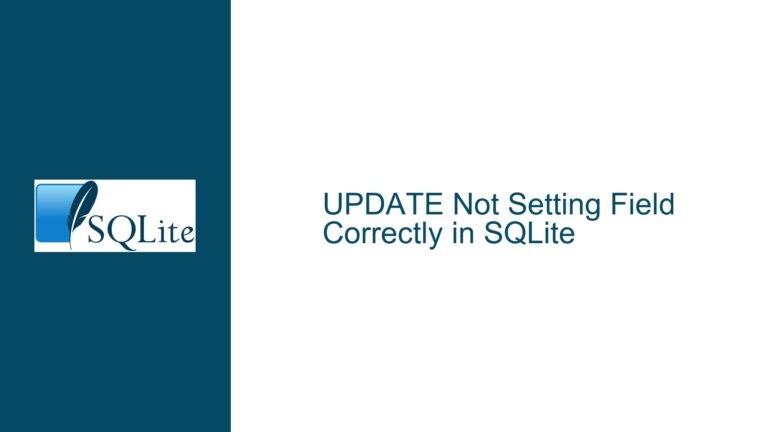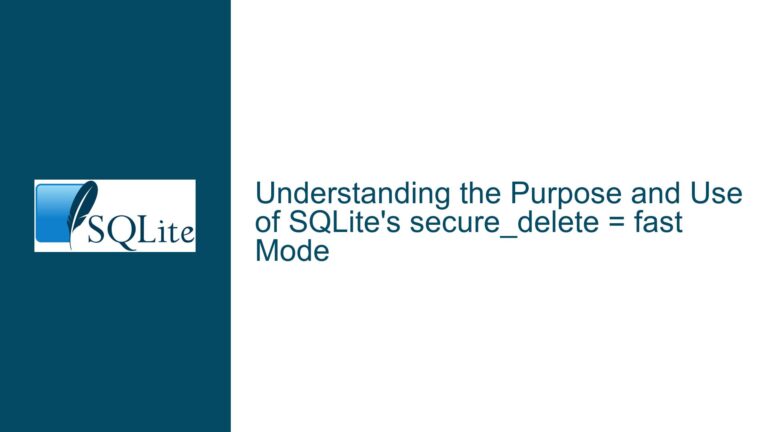ExecuteNonQuery Returns Incorrect Row Count for DELETE Operations
Understanding the Discrepancy Between Expected and Reported Affected Rows
The core issue involves the ExecuteNonQuery method in the system.data.sqlite wrapper (version 1.0.115.0) returning an incorrect number of affected rows after executing a DELETE FROM tableName statement. Users observe that the returned count exceeds the actual number of deleted rows, with the discrepancy increasing as the table grows (e.g., deleting 200 rows returns 203, deleting 5015 rows returns 5399). This anomaly does not occur in older wrapper versions (e.g., 1.0.113.0) or when appending a tautological condition like WHERE 1=1 to the DELETE statement.
The problem is isolated to scenarios where the DELETE command lacks a WHERE clause and interacts with the RETURNING keyword. The discrepancy arises from how the wrapper interprets the SQLite engine’s response to DML operations, particularly when the RETURNING clause is implicitly or explicitly involved. The SQLite shell and third-party tools like DB Browser for SQLite report correct counts, confirming the issue resides in the interaction between the wrapper and the SQLite engine.
Root Causes of Incorrect Affected Row Counts in system.data.sqlite
1. Misinterpretation of the RETURNING Clause in DML Statements
SQLite introduced the RETURNING clause in version 3.35.0 (2021-03-12) to allow DML operations to return modified rows. However, the RETURNING clause is not designed for use in subqueries or nested projections. When a DELETE statement with RETURNING is executed, SQLite streams the deleted rows back to the client. The system.data.sqlite wrapper may erroneously interpret each returned row as an "affected row," inflating the count. For example, deleting 1004 rows with DELETE FROM table1 RETURNING 1 causes the wrapper to process 1004 result rows (each containing the value 1), leading it to report 1004 "changes" instead of the correct count.
This misinterpretation is exacerbated when the DELETE statement lacks a WHERE clause. The wrapper’s logic for parsing the command text might conflate the RETURNING output with the actual number of rows deleted, especially if internal APIs like sqlite3_changes are not invoked correctly.
2. Version-Specific Behavior in system.data.sqlite
The problem surfaced after upgrading from system.data.sqlite 1.0.113.0 to 1.0.115.0, indicating a regression or intentional change in how the wrapper handles DML responses. Earlier versions likely relied on sqlite3_changes (which returns the correct number of rows modified by the last operation) to populate the ExecuteNonQuery result. Newer versions might erroneously use sqlite3_data_count or similar APIs that count the rows returned by RETURNING, leading to inflated values.
3. Ambiguity in Command Text Parsing
The absence of a WHERE clause in the DELETE statement may trigger an edge case in the wrapper’s SQL parser. When a DELETE command is issued without conditions, the wrapper might default to a different execution pathway that inadvertently processes RETURNING output. Adding a no-op condition like WHERE 1=1 forces the wrapper to use a standard parsing routine, bypassing the flawed logic.
Resolving the Affected Row Count Mismatch
Step 1: Confirm SQLite and Wrapper Compatibility
- Check SQLite Version: Ensure the underlying SQLite engine is ≥3.35.0 (required for
RETURNING). UseSELECT sqlite_version();to verify. - Validate Wrapper Behavior: Test the
DELETEoperation with system.data.sqlite 1.0.113.0 and 1.0.115.0 to confirm the regression.
Step 2: Modify the DELETE Statement Structure
- Add a Tautological Condition: Rewrite
DELETE FROM tableNameasDELETE FROM tableName WHERE 1=1. This forces the wrapper to parse the statement as a conditional delete, avoiding the faulty execution pathway. - Avoid RETURNING in ExecuteNonQuery: Do not use
RETURNINGwithExecuteNonQuery, which is designed for commands that do not return data. UseExecuteReaderorExecuteScalarif you needRETURNINGoutput.
Step 3: Adjust Wrapper Configuration or Downgrade
- Downgrade to system.data.sqlite 1.0.113.0: If feasible, revert to the older wrapper version until the issue is resolved upstream.
- Monitor Wrapper Updates: Check the system.data.sqlite GitHub repository for patches or discussions related to
ExecuteNonQueryandRETURNING.
Step 4: Directly Use SQLite APIs for Validation
- Use sqlite3_changes in Native Code:
using (var cmd = connection.CreateCommand()) { cmd.CommandText = "DELETE FROM tableName"; cmd.ExecuteNonQuery(); var changes = connection.Changes; // Uses sqlite3_changes under the hood }The
SQLiteConnection.Changesproperty directly maps tosqlite3_changes, providing the correct count.
Step 5: Report the Issue to Maintainers
- File a Bug Report: Provide a minimal reproduction case using the following code:
using (var conn = new SQLiteConnection("Data Source=test.db")) { conn.Open(); using (var cmd = conn.CreateCommand()) { cmd.CommandText = "DELETE FROM tableName"; int reportedChanges = cmd.ExecuteNonQuery(); // Compare with conn.Changes } }
Step 6: Educate Teams on RETURNING Clause Limitations
- Subquery Restriction: The
RETURNINGclause cannot be used in subqueries. For example,SELECT COUNT() FROM (DELETE FROM table RETURNING 1);is invalid. - Application-Level Handling: Use
RETURNINGonly withExecuteReaderto process the returned rows separately from the affected row count.
By addressing the wrapper’s misinterpretation of RETURNING output, ensuring compatibility between components, and modifying command text to avoid ambiguous parsing, developers can resolve the inflated affected row counts and restore reliable data operations.






